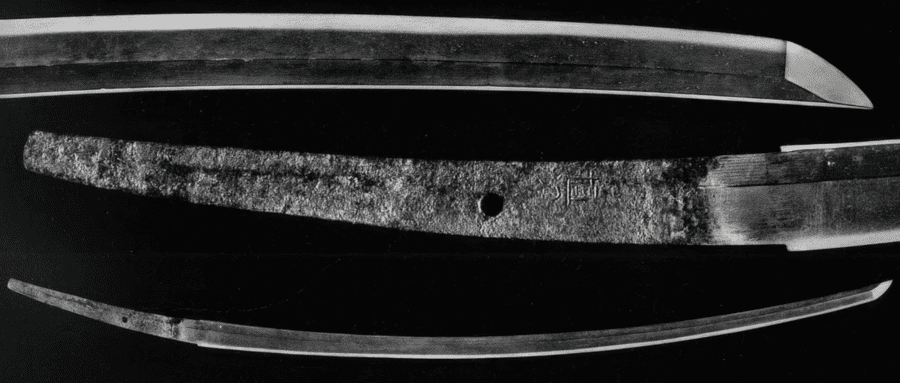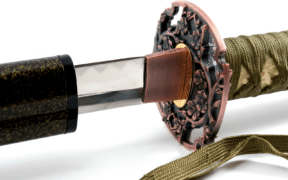Famous Examples of Japanese Swords from Mythology
NO AI USED This Article has been written and edited by our team with no help of the AI

Japan is home to some of the most fascinating real and mythological swords. Mythical tales of swords are important in Japanese culture and have persisted for thousands of years. These myths have fueled the creation of iconic samurai swords such as the katana and tachi.
Interestingly, some mythological swords are currently on display in museums.
In this article, we explore the most famous examples of Japanese mythological swords. These range from the well-known Muramasa swords to lesser-known examples associated with the creator of the universe.
1. Yawarakai-Te

The Yawaraki-Te, sometimes known as the “Tender Hands Sword,” is a blade shrouded in legends dating back centuries. Some stories originated after the Edo Period (post-18th century) and some have their origin in modern anime.
The Yawaraki-Te was created by one of Japan’s greatest sword makers, Goro Nyudo Masamune, revered as one of the finest swordsmiths of all time.
“It is widely known that Masamune is one of the pioneers of the Soshu tradition (the iconic style of the Japanese katana),” says Markus Sesko, an expert on Japanese swords and armor.
According to legend, the sword was perfectly crafted and intended only for noble deeds. In one tale, during a competition, the blade was lowered into a current; it only cut leaves and did not harm the innocent fish swimming nearby, which seemed merely to brush against it.
2. Juuchi Yosamu

The Juuchi Yosamu, known as “10,000 Cold Nights,” is very different to the Yawaraki-Te. Its creator, Muramasa, another of Japan’s great historical smiths, is notorious for his malevolent deeds and cursed swords.
The tales about Muramasa describe him as a troubled man with many demonic qualities, which he allegedly transferred to his swords, including the Juuchi Yosamu. The sword is said to have hissed through the air. In competitions, it cut through everything.
Some legends suggest that it gave those who wielded it a thirst for blood and eventually drove them mad.
3. Ame-no-Habakiri

The Ame-no-Habikiri, or the “Snake-Slayer of Heaven,” is one of the earliest mythological Japanese swords. It was carried by Susanoo, the Shinto god of the storms and sea. He used it to defeat an evil serpent/dragon named Yamato-no-Orochi, cutting off its eight heads and tails after luring it with sake.
There are many visual interpretations of the Ame-no-Habikiri, but the most common is the Japanese double-edged tsurugi sword. This ancient blade was used well before the emergence of the curved katana or tachi.
4. Kusanagi-no-Tsurugi

When Susanoo killed the 8-tailed serpent, he discovered Japan’s second most popular mythological sword inside – the Kusanagi-no-Tsurugi. Known as the “Grass Cutting Sword,” it is a national treasure of Japan and part of the Three Sacred Imperial Regalia.
This sword features in many myths and legends, including one where it chases the sun goddess Amaterasu, bringing shadow and darkness to the land. One famous tale involves Yamato Takeru, who used the blade to control the wind and extinguish a flaming grass field, hence its name.
5. Dojikiri Yasutsuna

The Dojikiri Yasatsuna, known as “The Demon Cutter,” is one of the Tenka Goken, or “Five Swords under Heaven.” It is housed in the Tokyo National Museum and is associated with many myths and legends.
It was supposedly created by Yasatsuna, the founder of the Hoki school and the greatest smith of Japan’s Heian Period.
Centuries after its creation, it allegedly found its way into the hands of Japan’s three unifiers. According to legend, it was carried by Minamoto no Yorimitsu, a Heian general who led his guardians, the shitenno, dressed in the costumes of Buddhist monks, and defeated an oni (demon) known as Shuten-doji near Kyoto.
6. Onimaru Kunitsuna

Another existing sword linked with many mythological stories is the Onimaru Kunitsuna. This weapon also belonged to Minamoto no Yorimitsu and was forged by Kunitsuna, a swordsmith from the Osafune school. It is part of the Tenka Goken and is highly valued.
According to legend, this sword could wield itself and take down demons, earning it the nickname “Demon” or “Demon Circle.”
In one story, Raikou was ill and bedridden when a demon seized the opportunity to attack. His guardian, named Tsuna, fended off the demon using the Onimaru.
7. Juzumaru Tsunetsugu

Another example of a Japan National Treasure piece and also one of the Five Swords Under Heaven is the Juzumaru Tsunetsugu. It is considered a sacred relic of Nichiren Buddhism.
It is said to have warded off evil spirits during the Kamakura period (around the 13th century) and to possess a similar power to this day.
The sword is housed inside the Honkoji Temple and is shown to the public annually on the 3rd of November. It was crafted by the renowned swordsmith, Tsunetsugu Ko-Aoe. Traditionally, monks wrap the handle with a rosary.
8. Mikazuki Munechika

The Mikazuki Munechika is shrouded in myth and frequently depicted in Japanese art. Its name, which means “crescent,” refers to its crescent-moon-like curve and the qualities of its blade.
It is said that the sword was crafted by the legendary smith, Munechika during the Heian Period, with the assistance of the Inari god. This deity, or kami, is associated with general prosperity and good fortune, which the sword is also said to bring.
The deity is said to have appeared in the form of a young boy to aid Munechika in his work. The Mikazuki Munechika is also housed in the Tokyo National Museum.
9. Odenta Mitsuyo

The last of the Tenka Goken swords is the Odenta Mitsuyo, crafted by the similarly named Mitsuyo Denta. This sword, which still exists, is regarded as one of the founding regalias and heirlooms of the Ashikaga Shogunate, giving it a significant place in Japanese history.
The Odenta Mitsuyo is said to possess magical healing properties. Legend has it that it healed the princess of the Maeda Clan when she was on her deathbed. Since then, the sword has been revered by the local people and owned by the Maeda family.
It is also said to benefit local farming and storage, as it supposedly chases away birds and crows when stored in a warehouse.
10. Kogarasu Maru

The Kogarasu Maru represents a blend of single and double-edged Japanese swords. It’s said to have been crafted by the fictional swordsmith Amakuni, who created legendary samurai swords, notably the katana and tachi.
This blade features a double-edged tip and is known as “Little Crow.” There are several theories concerning its origin. According to one of them, after seeing many broken swords in battle, Amakuni vowed to forge an unbreakable one.
After seven days of crafting and praying to the Shinto gods, he produced the Kogarasu Maru. It is stored in the Japanese Imperial Collection.
11. Ame-no-ohabari

The Ame-no-Ohabari is a mythological sword found in Izumo mythology. It translates as “Heaven-Point-Blade-Extended” and is associated with Izanagi, the deity known as the creator of life and everything.
It is said that Izanagi used the sword to cut the infant Fire god Kagutsuchi after he caused fire damage. Kagutsuchi was cut into eight pieces, creating eight volcano gods. Out of the blood spilt during this act, two more gods were created—the gods of the Sea and the Rain.
Although the Ame-no-Ohabari is not physical, it is most commonly depicted in art as a double-edged blade.





